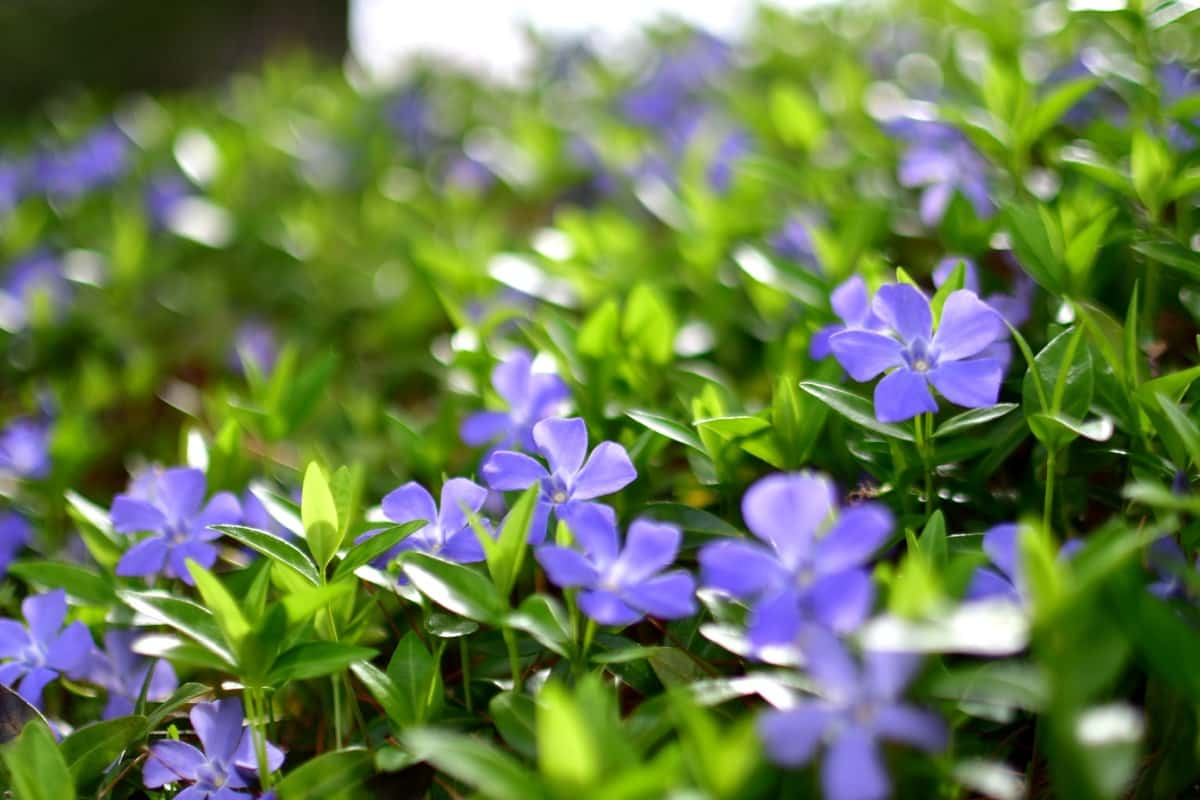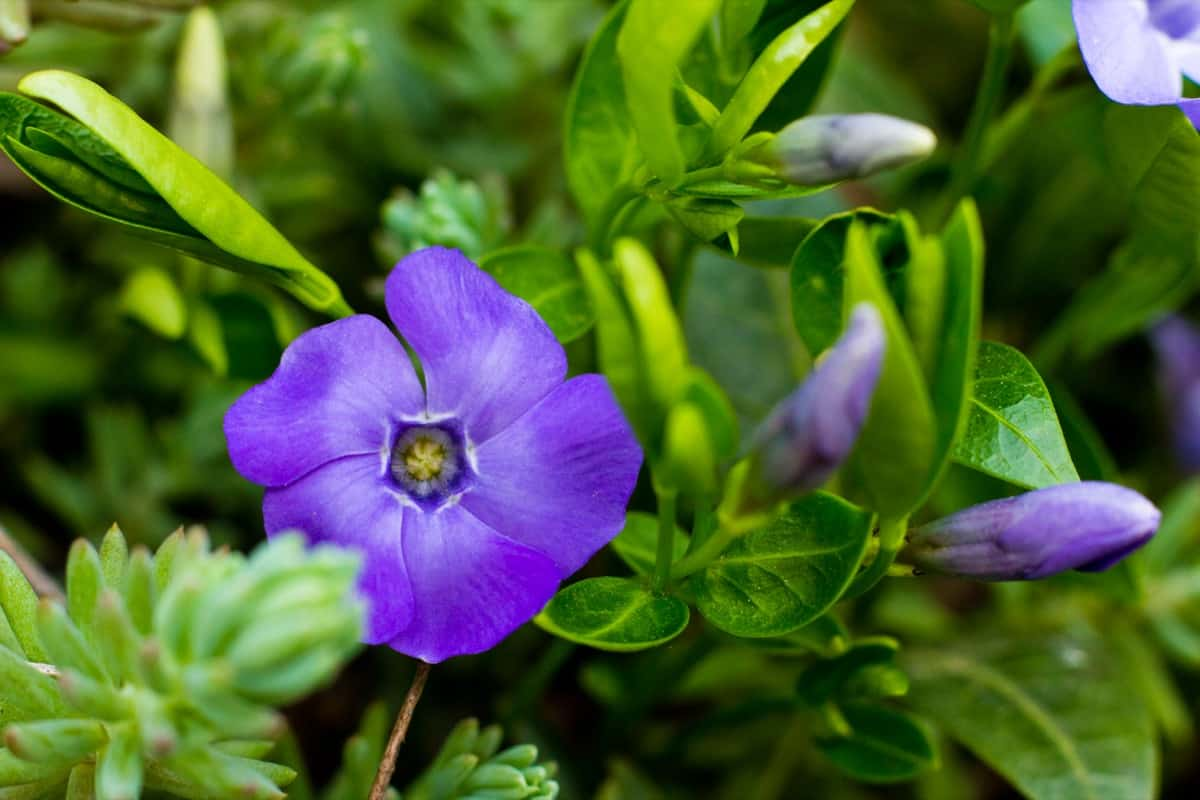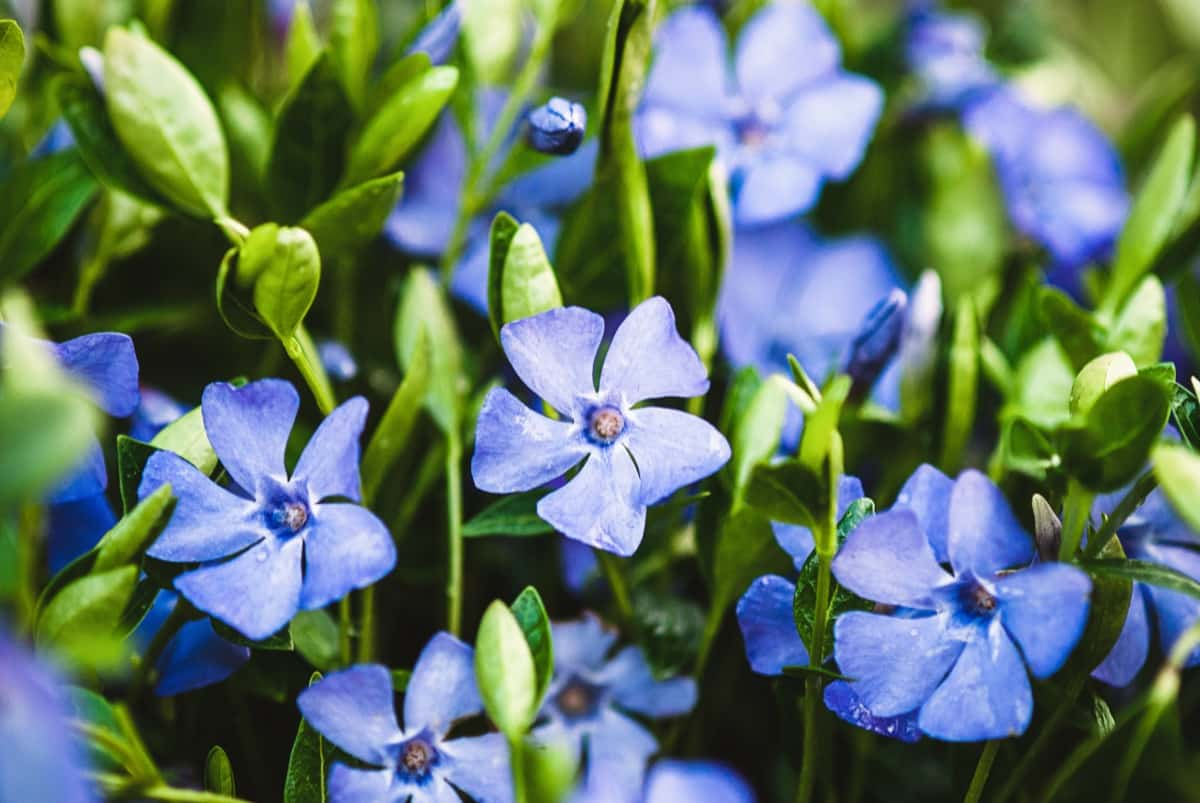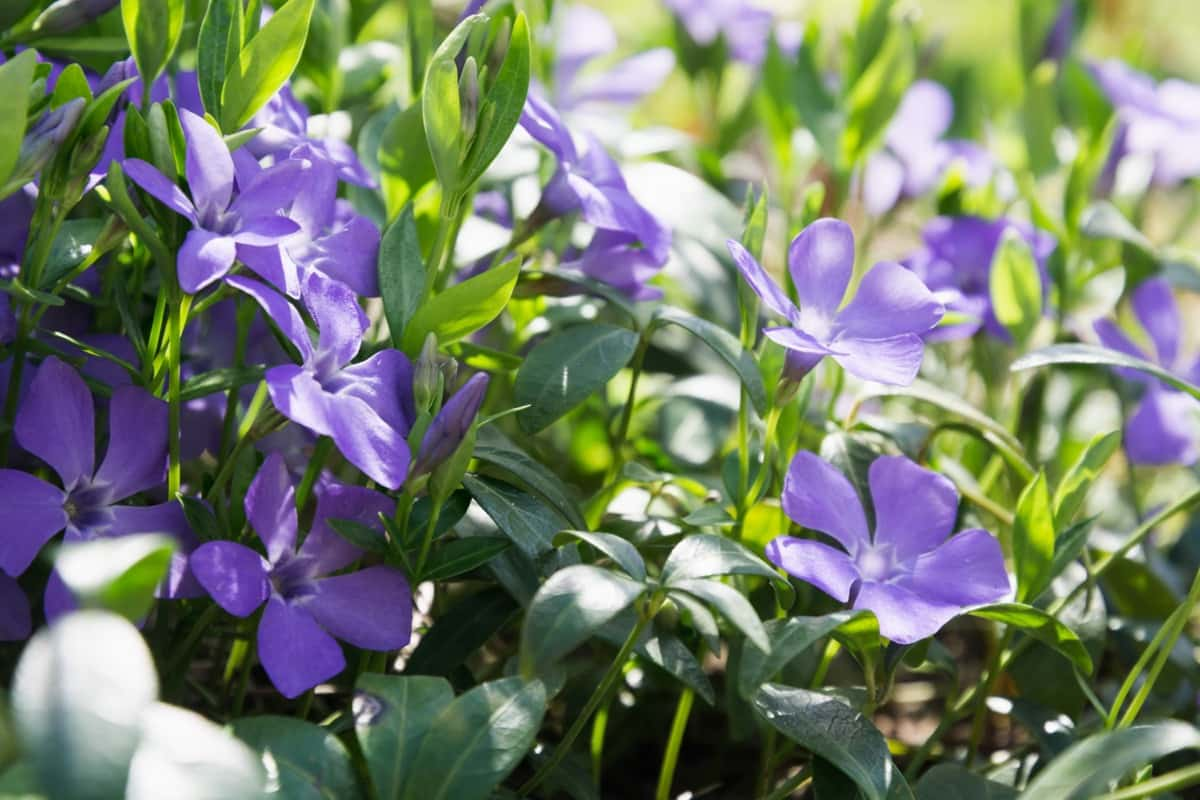Periwinkle flowers, also known as Vinca, are perennial flowering plants known for their vibrant blues and purples. With delicate petals and lush leaves, periwinkles serve as a charming addition to any garden. The following guide takes a comprehensive look into growing and caring for these lovely blooms. Periwinkle flowers can enhance your gardening, whether you’re a beginner or an experienced gardener.

How to Grow and Care for Periwinkle Flowers
Best Soil Conditions for Growing Periwinkle
Just like any other plant, periwinkles require specific soil conditions for optimal growth. These plants can grow in different soils, but they like well-draining soil with a slightly acidic pH. A soil mix with lots of organic matter is best for their strong growth. Improve the drainage of heavy or clayey garden soil by adding compost or manure. Remember, poor drainage can lead to root rot, a common issue that can plague Periwinkle plants. Regularly check the soil for its pH level and nutrient content, and adjust as necessary.
Propagating Periwinkle from Cuttings
The process of propagating periwinkles from cuttings is simple. During early summer, when the plants are actively growing, it is recommended to select a healthy stem measuring 4-6 inches in length and containing multiple leaf nodes. Prune the stem below a node, ensuring to retain a few upper leaves while eliminating the lower ones. To promote root growth, immerse the cut end of the stem in rooting hormone.
In case you missed it: How to Grow and Care for Prickly Pear: A Comprehensive Guide for Beginners

Subsequently, place the stem in a pot filled with a moistened mixture of perlite and peat moss. Create a humid environment by covering the pot with a plastic bag and position it in a warm area with indirect sunlight. After a 4-6 week period, the cutting should have established roots and can be transferred to a larger container or planted directly in the garden.
Watering Tips for Periwinkle Plants
Periwinkles are drought-tolerant plants, but they do need regular watering, especially during the initial stages of growth. Water your Periwinkles deeply and thoroughly once or twice a week, ensuring the soil is kept moist but not waterlogged. The goal is to maintain consistent soil moisture levels without overwatering, as this could lead to root rot. It’s crucial to allow the soil to dry out slightly between waterings to avoid oversaturation. Once the plant is well-established, it can tolerate periods of dryness, making it a perfect plant for xeriscaping and areas prone to drought.
Sunlight Requirements for Periwinkle Growth
Sunlight is essential for Periwinkle plants to grow and develop. They thrive in both sunny and partially shaded areas. While they can tolerate different light levels, they produce their best and most abundant flowers when exposed to ample sunlight. Optimally, a minimum of six hours of direct sunlight daily is required. In regions characterized by hot climates and intense summers, it is advantageous to offer partial shade during the afternoon to shield the leaves from potential scorching.
In case you missed it: Expert Lawn Care Tips for Lush Green Garden

Pruning Techniques for Periwinkle
Pruning is an essential part of Periwinkle care as it encourages fuller growth and more abundant flowering. Prune the plants in early spring or late winter when they are dormant. To begin, eliminate any dead or injured stems. Then, trim one-third of the plant’s height to encourage fuller growth. Use sharp pruning shears for clean cuts and prevent the spread of disease. Regular maintenance pruning throughout the growing season can help control the plant’s spread and keep it in shape. You can also deadhead spent flowers to stimulate continuous blooming throughout the season.
Fertilizing Schedule for Periwinkle Flowers
Periwinkle flowers are not heavy feeders and typically do well with a yearly application of compost or a slow-release, balanced fertilizer. Apply fertilizer during the onset of the growth period, commonly in spring, to enhance the plant’s nutrient composition. For Periwinkles, it is recommended to use a well-balanced fertilizer like 10-10-10, which contains equal proportions of Nitrogen, Phosphorous, and Potassium.
In case you missed it: Top 12 Carnivorous Plants to Grow Indoors: Easy to Care and Maintain

This type of fertilizer facilitates robust and vigorous growth in the plants. Always follow the manufacturer’s instructions when applying fertilizer to prevent over-fertilization, which can harm the plants. Additional fertilization may be unnecessary if your soil is already rich in organic matter.
Protecting Periwinkle From Pests and Diseases
Periwinkle plants are generally pest-resistant but can sometimes be bothered by aphids, scale insects, and spider mites. Inspect your plants often for signs of pests. If you see an infestation, use natural insecticidal soap or targeted pesticide to treat them. Periwinkles can also suffer from diseases like leaf spots and root rot, especially if they are waterlogged or lack proper air circulation. Regular pruning can help improve airflow, and proper watering techniques can prevent waterlogging. Maintaining overall plant health and vigor is the best way to protect your Periwinkles from pests and diseases.
Transplanting Periwinkle to a New Location
If you need to move your Periwinkle to a new location in early spring before the plant starts growing actively. Begin by preparing the new planting site, ensuring the soil is well-draining and enriched with organic matter. Carefully dig around the plant to lift it from the ground, trying not to disturb the root system excessively. Move the plant to its new spot and replant it at the same depth as before. Water thoroughly after transplanting, and continue to provide regular care as the plant establishes itself in the new location.
In case you missed it: How to Take Care of Seedlings After They Sprout: A Beginners Guide

Mulching Tips for Periwinkle Beds
Mulching is a beneficial practice in Periwinkle care, providing many advantages. Mulch helps retain soil moisture, suppress weed growth, and regulate soil temperature, among other benefits. Spread 2-3 inches of natural mulch, like shredded bark or compost, around your Periwinkle plants without piling it against the stems. Mulching in early spring can help protect the plant’s roots from temperature fluctuations and keep the soil cool and moist during the hot summer months.
Winter Care for Periwinkle Plants
Periwinkle plants are hardy and usually survive winter conditions without extra care. However, some additional protection might be required in regions where winter temperatures drop significantly. Apply thick mulch around plant bases for root insulation against low temperatures. If there’s a severe frost or snow forecast, consider covering the plants with a frost cloth or burlap to protect them. Remember, winter care will largely depend on the specific climate conditions in your area.
In case you missed it: DIY Mosquito Traps for Garden

Conclusion
Growing and caring for Periwinkle flowers is rewarding, bearing beautiful blooms and adding a charming touch to any garden. Following these steps, you can nurture healthy, vibrant Periwinkle plants and enjoy their striking appeal season after season.
- Seasonal Flower Gardening: Best Practices for Spring, Summer, Fall, and Winter
- How to Grow Hibiscus from Flower
- Plantation Ideas for Home Decoration: A Beginners Guide
- Flower Garden Designs and Layouts for Beginners
- Planting and Spacing Techniques in Papaya: A Beginner’s Guide
- Growing Gold: Essential Techniques for Planting Pineapples
- How to Make Kalanchoe Plant Bushy: Home Remedies and Solutions
- 11 Reasons Why Your Gardenia is Not Blooming: Home Remedies and Solutions
- Eco Elegance: The Guide to Designing a Drought-Tolerant Landscape
- Gardening on a Slope: Strategies for Hillside Landscaping
- Nourish and Flourish: Top Organic Mulches for Thriving House Plants
- Everything You Want to Know about Indian Mogra Flower: Discover Uses and Growing
- Green Thumb Success: Expert Tips for Cultivating Greenhouse Pumpkins All Year Round
- Maximize Growth & Flavor: The Ultimate Guide to Companion Planting in Herb Gardens
- How to Control Rhododendron Problems Naturally: Home Remedies and Organic Ways to Fix Them
- Natural Magic: The Remarkable Benefits of Cinnamon for Plants
- Best Steps to Revive Dying Tulip with Natural and Organic Treatment
- 10 Reasons Why Your Angel Trumpet is Not Blooming: Remedies and Treatment
- How to Fix Periwinkle Leaf and Flower-Related Problems: Natural Remedies and Solutions
- How to Fix Zinnias Leaf and Flower Problems: Discover Natural and Home Remedies
- Organic Steps to Induce Lemon Tree Flowers: A Comprehensive Guide
- Bloom Booster: Crafting the Perfect Homemade Bougainvillea Fertilizer
- Optimizing Growth: A Guide to Applying NPK Fertilizer for Potted Plants
- 10 Best Homemade Fertilizers for Rubber Plant: DIY Recipes and Application Method
- How to Boost Female Pumpkin Flowers: Effective Steps for More Flowers and High Yields
- Transform Your Indoor Garden: Top Benefits of Pink Salt for Houseplants
- 10 Best Homemade Fertilizers for Peacock Plants (Calathea): Easy DIY Guide
- Unlock Blooms: 9 Reasons Why Your Potted Chrysanthemum is Not Blooming
- 8 Reasons Why Your Potted Hibiscus is Not Blooming: Fix it with Simple Solutions
- Unlock Blooms: 9 Key Reasons Your Potted Frangipani Won’t Flower
- 10 Reasons Why Is My Ice Plant Not Blooming: Remedies and Treatment
- 10 Reasons Why My Potted Hydrangea Not Blooming: Treatment and Remedies
- 10 Reasons Why is My Wisteria Not Blooming: Remedies and Treatment
- 10 Reasons Why is My Goldfish Plant Not Blooming: Remedies and Treatment
- Maximize Your Space: Ultimate Guide to Balcony Gardening with Grow Bags
- 10 Reasons Why Your Iris is Not Blooming: Remedies and Treatment